Mobile Transporation Conveying in Manufacturing and Distribution: The Future of Material Handling
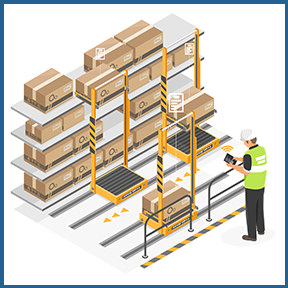
Vector illustration of automated guided vehicles moving on predetermined paths to perform tasks within a warehouse.
OVERVIEW
Mobile transportation conveying systems have revolutionized the way materials are handled in manufacturing and distribution facilities. These advanced systems streamline the movement of goods, reducing manual labor, increasing efficiency, and enhancing overall productivity. Mobile conveyors operate using sophisticated technologies that enable them to navigate facilities autonomously or semi-autonomously, ensuring precise and timely delivery of materials.
IMPORTANCE IN MATERIAL HANDLING
The primary importance of mobile transportation conveyors lies in their ability to automate the transport process, reduce human error, and optimize logistics within a facility. By integrating these systems, companies can achieve faster throughput, better space utilization, and a safer working environment.
Request Quote ---- JOIN OUR MAILING LIST ---- Contact Us
Types of Mobile Transport Conveying Systems
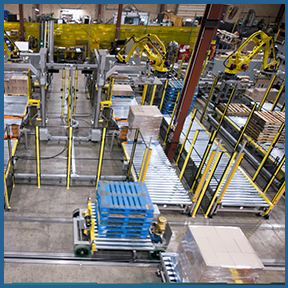
System with a transfer car that moves finished loads to stretch wrapping area and delivers empty pallets to the palletizing cells.
1. TRANSFER CARS
Transfer cars, also known as rail-guided vehicles, are designed to move materials along predefined paths within a facility. They run on embedded tracks or rails and are commonly used for transporting heavy loads over short distances, often between palletizing, wrapping, and labeling cells within automated robotic systems utilized in manufacturing and distribution industries.
ADVANTAGES:
- High Load Capacity: Capable of carrying heavy and bulky materials.
- Reliability: Operate on fixed tracks, minimizing the chances of deviation or collision.
- Cost-effective: Lower initial investment compared to more sophisticated systems like AGVs or AMRs.
BEST APPLICATIONS:
- Steel Mills: Moving large steel coils or billets.
- Automotive Plants: Transporting car bodies or large assemblies between workstations.
- Warehouses: Shuttling pallets between storage areas.
- Automated Packaging Solutions: Shuttling empty pallets and palletized loads between different palletizing, wrapping, and labeling cells in systems utilized by manufacturing & distribution industries.
REAL WORLD EXAMPLE:
A leading automotive manufacturer implemented transfer cars to move car bodies between different stages of assembly. This integration reduced manual handling, increased production speed, and improved safety by minimizing forklift traffic.
Find out specifically about Kaufman Engineered Systems transfer cars.
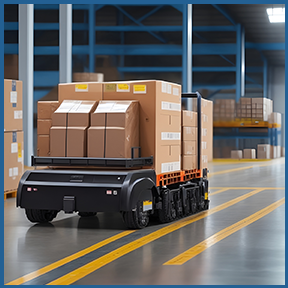
AGV transporting a load of products following a predetermined path on the floor.
2. AUTOMATED GUIDED VEHICLES (AGVs)
AGVs are autonomous vehicles that follow predetermined paths using embedded floor markers, magnetic strips, or laser guidance. They are highly versatile and can be customized for various material handling tasks.
ADVANTAGES:
- Automation: Fully autonomous operation reduces the need for manual intervention.
- Flexibility: Can be programmed to handle different routes and tasks.
- Efficiency: Continuous operation with minimal downtime.
BEST APPLICATIONS:
- Manufacturing Plants: Transporting components between production lines.
- Distribution Centers: Moving goods from receiving docks to storage areas.
- Hospitals: Delivering medical supplies within healthcare facilities.
REAL-WORLD EXAMPLE:
An electronics manufacturer introduced AGVs to transport components between assembly lines and storage areas. The result was a 30% increase in production efficiency and a significant reduction in material handling costs.
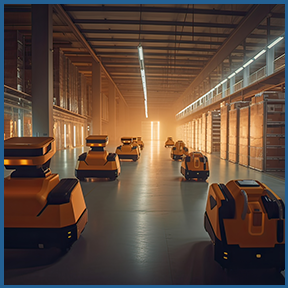
Laser Guided Vehicles (LGV) using gps to go exactly where they're needed to perform tasks within warehouse, manufacturing, and distribution facilities.
3. LASER GUIDED VEHICLES (LGV)
LGVs are a type of AGV that uses laser sensors for navigation. They offer higher precision and flexibility compared to traditional AGVs, making them suitable for complex environments.
ADVANTAGES:
- Precision: Laser navigation allows for accurate positioning and movement.
- Adaptability: Easily reconfigurable routes without physical changes to the facility.
- Scalability: Can integrate into existing systems and expand as needed.
BEST APPLICATIONS:
- Pharmaceutical Industry: Transporting sensitive products within a controlled environment.
- Food and Beverage: Moving products through various stages of processing and packaging.
- Retail Warehousing: Efficiently handling diverse product types and sizes.
REAL-WORLD EXAMPLE:
A global pharmaceutical company implemented LGVs in their distribution center to handle delicate and high-value medications. This led to improved accuracy in order fulfillment and enhanced inventory control.
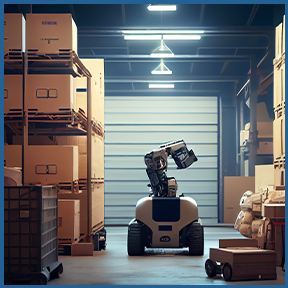
Autonomous Mobile Robot (AMR)
AUTONOMOUS MOBILE ROBOTS (AMR)
AMRs represent the latest advancement in mobile conveying technology. Unlike AGVs, AMRs do not require fixed paths; instead, they use advanced sensors, cameras, and onboard intelligence to navigate dynamically.
ADVANTAGES:
- Intelligence: Can make real-time decisions based on the environment.
- Flexibility: Easily adaptable to changing layouts and tasks.
- Interactivity: Can interact with other automated systems and human workers safely.
BEST APPLICATIONS:
- E-commerce Fulfillment: Rapid order picking and sorting in dynamic environments.
- Manufacturing: Assisting in just-in-time delivery of parts to assembly lines.
- Healthcare: Autonomous delivery of medical supplies, samples, and equipment.
REAL-WORLD EXAMPLE:
An e-commerce giant deployed AMRs in their fulfillment centers to manage high-order volumes during peak seasons. This integration resulted in a 40% increase in order processing speed and enhanced scalability.
Benefits of Mobile Transportation Conveyors
Mobile transportation conveying systems are transforming material handling in manufacturing and distribution facilities. Transfer cars, AGVs, LGVs, and AMRs each offer unique advantages and are suited for specific applications, providing flexibility, efficiency, and reliability. As technology continues to evolve, these systems will become even more integral to operations across various industries, paving the way for smarter, more automated logistics solutions.
KEY TAKEAWAYS
- Mobile conveyors improve efficiency and safety in material handling.
- Transfer cars are ideal for heavy loads over short distances.
- AGVs offer flexibility and automation for a variety of tasks.
- LGVs provide precise navigation and adaptability.
- AMRs bring advanced intelligence and flexibility to dynamic environments.
FUTURE POSSIBILITIES
The future of mobile transportation conveying holds exciting possibilities with advancements in AI, machine learning, and IoT integration. These technologies will further enhance the capabilities of mobile conveyors, making them smarter, more efficient, and even more integral to modern manufacturing and distribution operations.
Request Quote ---- JOIN OUR MAILING LIST ---- Contact Us
